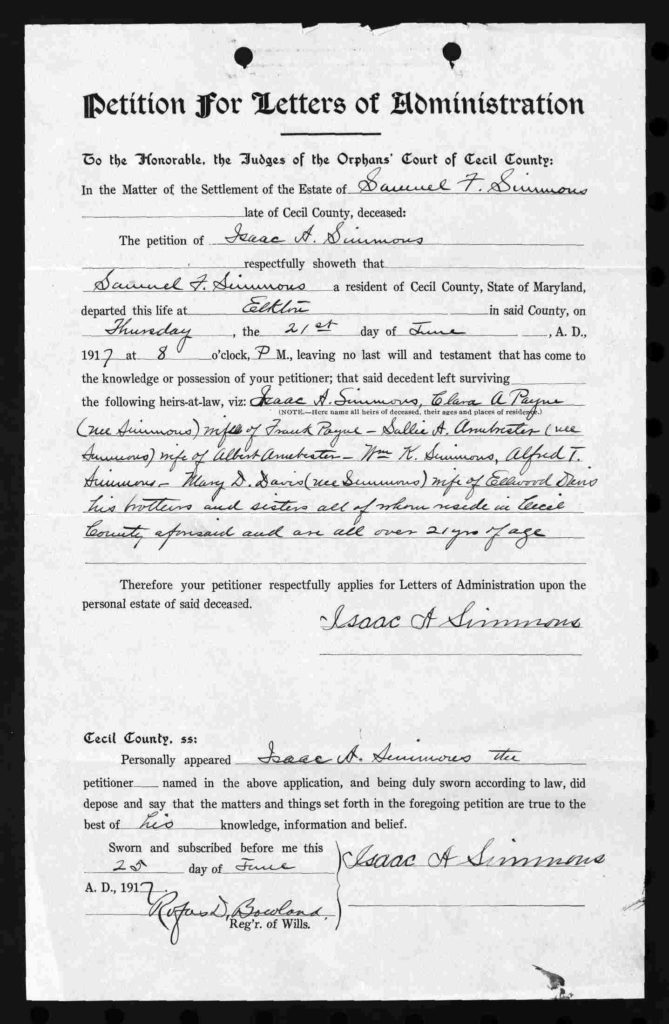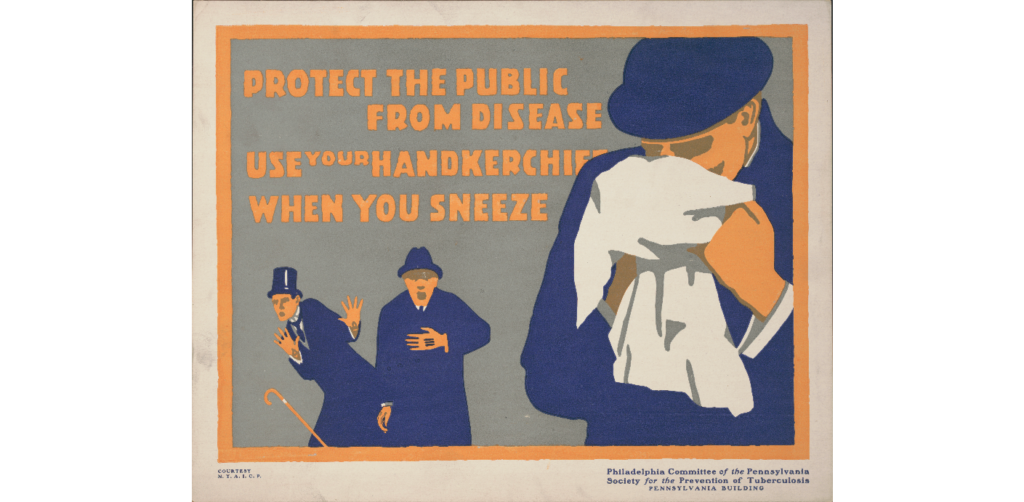Samuel F Simmons was born in July 1877 in Maryland. He married Hannah P Ward (born about 1877 in Delaware) on March 27, 1902, in Delaware. They had at least one child, Samuel Ward, who was born around 1910. Samuel Sr died on June 21, 1917, at the age of 39, along with his wife and son, in an automobile versus train accident. The family was buried in Bethel Cemetery in Chesapeake City.
Common disasters happen, as I mentioned in my last post on the subject. Sometimes, though, it takes some work to tease the information out.
I was tracking Samuel Sr. from his parents’ family record, and therefore had his approximate birth year. On Ancestry, I found his marriage record to Hannah in 1902, and then found the 1910 census record showing the pair and their son Ward, born 1910. (Probably, there were more children between 1902 and 1910, but Maryland’s death records are slim and it’s difficult to find the children who die in the gaps.) But then all records petered out.
I did what I usually do in that case: hop over to FamilySearch.org and poke around in their databases. And there I found Maryland probate records for Samuel F Simmons from 1917. Since I couldn’t find him in the 1920 census, that seemed very likely. So I popped it open.
First thing I saw was that it was filed on June 25, 1917 — so now I knew that he’d died before then, in the first half of the year. Page 2, though, was the kicker.

What do we see here?
- Date and time of death: Thursday, June 21, 1917, at 8 pm.
- Hannah Simmons is not listed among the heirs-at-law, nor is she the executrix — the executor is the brother of the deceased.
- Neither is Ward Simmons.
- Oh, and I now had the married names for the 3 sisters I’d despaired of finding. That was awesome.
Pages 3-6 are signatures and other housekeeping; page 7 begins the inventory of the estate. Beyond that was information that Samuel had been a tenant farmer, and his brother Isaac was ordered to take up his lease and fulfill the conditions of the lease, selling milk from the cows and tending and harvesting the farm, in order to benefit the estate. The original lease from 1910 was included, with all its terms. And then the final account of the estate was included with all items sold at public and private sale.
In the account were more items of interest, including:
- Benefits due the deceased from the Patriotic Order Sons of America: $299.00
- Benefits due the deceased from the Metropolitan Life Insurance Company: $985.06
- Benefits due from the Metropolitan Life Insurance Company on death of son: $85.30
- Amount received from sale of wrecked automobile: $10.00
- Amount received from suit against the Railroad Company for damage to the automobile: $232.95
- Amount received from PW&B RR (Philadelphia, Wilmington & Baltimore Railroad) for funeral expenses: $529.35
And then in the outlay from the estate:
- For amt paid, funeral expenses for Samuel F Simmons: $157.75
- Mrs. Samuel F Simmons: $158.35
- Ward Simmons: $60.25
- Burial plot: $61.50
A common disaster indeed!
With the date in hand, I went delving into newspaper archives online, but to no avail. I did, however, discover an obliging historical society in the area, with online payment for searching and scanning their newspaper archive. I wrote them with the following result.

Shortly after 8 o’clock Thursday night, four persons were killed at the Bridge street crossing of P, B. & W. Railroad in Elkton. They were Samuel Simmons, a farmer near Elkton; Mrs. Hannah Simmons, his wife; Ward Simmons, aged about 8 years, their son, and Geo. Foster, a farm hand in Mr. Simmons employ. The accident wiped out Mr. Simmons’s entire family.
*The pilot of the locomotive is also known as the cowcatcher — it’s that plow-shaped bit on the front.
The Bridge street crossing where the accident occurred has been the scene of several sad affairs, but none in magnitude compared with the latest one.
Completing his day’s work on the farm, Mr. Simmons accompanied by his wife, child and hired man started in his new Ford automobile for the farm of Frank B. Evans, just north of Elkton, to spend a short time with the family of Joseph McKinney. Everything went well all the way to the railroad. Upon approaching the railroad crossing, the driver of the car noticed the safety gates were still up and he undertook to go across the tracks. Just as the machine was about in the middle of the northbound track, the locomotive attached to train No. 432, New York and Washington express, running at a speed of about 60 miles an hour, crashed into it, and the car, together with the four occupants, was whirled through the air. The body of Mr. Foster lodged on the pilot* of the locomotive and remained there until the train was stopped. The bodies of all four of the victims were [unreadable] mutilated, and the automobile was broken into thousands of pieces.
Coroner Herbert D. Litzenberg had the bodies removed to the undertaking establishment of Vinsinger & Pipple, and he summoned the following jury of inquest over the remains, which viewed the bodies that night and met yesterday to hear testimony: Taylor W McKenney, C.P. Bartley, Fred H. Leffler, Charles S. Boulden, Daniel Henry, Edward M. Johnson, Harry R. Boulden, A Alexander, George Potts, Alfred Taylor, Harry Buckworth, Wm. Henry Biddle.
The jury rendered the following verdict: That Mr. and Mrs. Samuel Simmons, Ward Simmons and George Foster came to the death by being struck by train No 432 on the Pennsylvania Railroad, Thursday evening, June 21; that the cause of death was carelessness and negligence of John Lotman, the gate-keeper employed by the Pennsylvania Railroad, at this point, at that time, and to the criminal carelessness and neglect of the said Pennsylvania Railroad Company in its failure to secure and train competent employees to attend the dangerous grade crossings in this town. This jury wishes to point out and to emphasize the grave danger of these crossings to the traveling public an the continued indifference of the Railroad Company in failing to take the necessary precautions in spite of the large number of accidents that have occurred at these points in this town. We respectfully request that the States Attorney of this county take criminal action against the Pennsylvania Railroad Company whom we consider primarily responsible for the criminal carelessness in failing to properly safeguard the traveling public
Funeral services of Mr. and Mrs. Simmons and son will be held at their late residence Sunday afternoon at 2 o’clock; interment at Bethel Cemetery. The funeral services of George Foster will be held in the Elkton M.E. Church on Sunday at 1230 o’clock, with interment in Elkton Cemetery.
John Lotman, the watchman, was placed under arrest yesterday, Friday afternoon.
Of interest, Wikipedia supplies that the PW&B Railroad moved the line north of Elkton to eliminate the grade crossings in the town in 1934 — the original line ran on a tight curve through town, which I imagine is how the train was hidden from view as Samuel began crossing the tracks.
Also of interest, a little poking around in the newspapers online reveal that John Lotman was released from Elkton jail in July, and his case was supposed to be heard in September. An article from December 1917 shows that not only was Lotman indicted for manslaughter, but also the track foreman, Malachi Rafferty, and Supervisor English were also indicted for manslaughter for knowingly retaining Lotman despite knowing he was incompetent. Sadly, I have been unable to discover the final judgments against the three.
So that is my slightly more complicated story of genealogical detective work for the week. I’ll see if I can root out something else interesting for next week.

